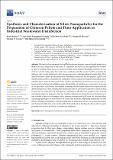| dc.contributor.author | Sartori, Paula | |
| dc.contributor.author | Longaray Delamare, Ana Paula | |
| dc.contributor.author | Machado, Giovanna | |
| dc.contributor.author | Devine, Declan M. | |
| dc.contributor.author | Crespo, Janaina S. | |
| dc.date.accessioned | 2023-01-17T10:54:37Z | |
| dc.date.available | 2023-01-17T10:54:37Z | |
| dc.date.copyright | 2023 | |
| dc.date.issued | 2023-01-02 | |
| dc.identifier.citation | Sartori, P.; Delamare, A.P.L.; Machado, G.; Devine, D.M.; Crespo, J.S.; Giovanela, M. (2023). Synthesis and characterization of silver nanoparticles for the preparation of Chitosan pellets and their application in industrial wastewater disinfection. Water, 15, 190. https://doi.org/10.3390/w15010190 | en_US |
| dc.identifier.uri | https://research.thea.ie/handle/20.500.12065/4363 | |
| dc.description.abstract | The use of silver nanoparticles (AgNPs) has become popular in several applications due to
their bactericidal properties. In this sense, it is ideal that the AgNPs are incorporated into a matrix
in order to minimize their release to the environment and to maintain their high reactivity. In view
of these facts, the main goal of this work was to synthesize and characterize AgNPs, evaluating the
influence of pH on the synthesis, for later incorporation into a chitosan polymeric matrix that will be
used in the form of pellets for the disinfection of industrial wastewater. For this purpose, AgNPs were
initially synthesized by a chemical route using silver nitrate, sodium borohydride and sodium citrate
and then characterized by ultraviolet-visible spectroscopy, transmission electron microscopy and as a
function of bacterial growth inhibition against Escherichia coli and Enterococcus faecalis. At the end
of this procedure, AgNPs were incorporated in chitosan and the pellets formed were employed in the
disinfection process, while assessing their bactericidal activity as well as the amount of silver leached.
In general, the results showed that AgNPs synthesized at pH 10.0 were smaller (3.14 0.54 nm)
and presented greater dispersion than the AgNPs synthesized at other pH values. Furthermore, it
was possible to observe a synergistic effect between chitosan and AgNPs and the chitosan pellets
containing AgNPs proved to be effective in wastewater treatment, destroying Escherichia coli after
60 min of treatment. Finally, by considering the ease of application, the low environmental impact
and the bactericidal action, it is concluded that the hybrid pellets developed in this work have great
potential to be used as auxiliaries in wastewater treatment. | en_US |
| dc.format | PDF | en_US |
| dc.language.iso | eng | en_US |
| dc.publisher | MDPI | en_US |
| dc.relation.ispartof | Water | en_US |
| dc.rights | Attribution-NonCommercial-NoDerivs 3.0 United States | * |
| dc.rights.uri | http://creativecommons.org/licenses/by-nc-nd/3.0/us/ | * |
| dc.subject | Silver nanoparticles | en_US |
| dc.subject | Chitosan | en_US |
| dc.subject | Wastewater treatment | en_US |
| dc.title | Synthesis and characterization of silver nanoparticles for the preparation of Chitosan pellets and their application in industrial wastewater disinfection | en_US |
| dc.type | info:eu-repo/semantics/article | en_US |
| dc.contributor.affiliation | Technological University of the Shannon: Midlands Midwest | en_US |
| dc.contributor.sponsor | CAPES (Finance code—001). | en_US |
| dc.description.peerreview | yes | en_US |
| dc.identifier.doi | 10.3390/w15010190 | en_US |
| dc.identifier.eissn | 2073-4441 | |
| dc.identifier.orcid | https://orcid.org/0000-0002-0727-232X | en_US |
| dc.identifier.orcid | https://orcid.org/0000-0002-1364-5583 | en_US |
| dc.identifier.orcid | https://orcid.org/0000-0002-0935-242X | en_US |
| dc.identifier.volume | 15 | en_US |
| dc.subject.department | PRISM: Polymer, Recycling, Industrial, Sustainability and Manufacturing Institute TUS Midlands | en_US |
| dc.type.version | info:eu-repo/semantics/publishedVersion | en_US |


